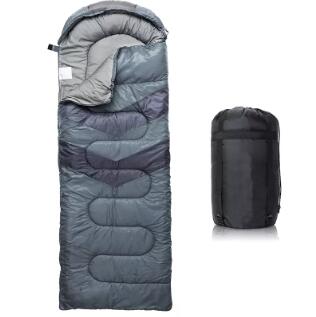Exploring the Temperature Range of Lightweight Compact Camping Sleeping Bags
2024-02-19
Introduction:
One of the key considerations when selecting a camping sleeping bag is its temperature rating. Understanding the temperature range for which a sleeping bag is designed is crucial for ensuring a comfortable and safe outdoor experience. In this blog post, we'll delve into the significance of temperature ratings for lightweight compact camping sleeping bags and how to interpret them effectively.
Importance of Temperature Ratings:
The temperature rating of a sleeping bag indicates the lowest temperature at which it can keep the average sleeper warm. This rating serves as a guide for campers to choose the appropriate sleeping bag for their outdoor adventures. Selecting a sleeping bag with the right temperature rating ensures comfort and prevents the risk of hypothermia or discomfort due to inadequate insulation.
Understanding Temperature Range:
Lightweight compact camping sleeping bags typically come with temperature ratings ranging from summer to extreme cold conditions. These ratings are often classified into three main categories:
1. Summer Sleeping Bags: Designed for warm weather camping, summer sleeping bags usually have temperature ratings above 32°F (0°C). They prioritize breathability and ventilation to prevent overheating during hot nights.
2. Three-Season Sleeping Bags: Ideal for spring, summer, and fall camping, three-season sleeping bags typically have temperature ratings ranging from approximately 20°F to 32°F (-6°C to 0°C). They offer adequate insulation to keep campers warm during chilly nights but may not be suitable for extreme cold conditions.
3. Winter Sleeping Bags: Engineered for cold weather camping and harsh winter conditions, winter sleeping bags have temperature ratings below 20°F (-6°C). These bags feature advanced insulation materials and construction techniques to provide maximum warmth and protection from freezing temperatures.
Factors Influencing Temperature Ratings:
Several factors can influence the temperature rating of a camping sleeping bag, including:
- Insulation Type: The type and quality of insulation material used in the sleeping bag significantly impact its ability to retain heat.
- Construction: The design and construction of the sleeping bag, such as baffles, draft collars, and hood design, play a crucial role in minimizing heat loss.
- User's Metabolic Rate: Individual differences in metabolism and cold sensitivity can affect how warm a sleeping bag feels to each camper.
- Environmental Conditions: External factors like humidity, wind chill, and ground insulation also influence the effectiveness of a sleeping bag's temperature rating.
Tips for Choosing the Right Sleeping Bag:
When selecting a lightweight compact camping sleeping bag based on temperature rating, consider the following tips:
- Assess the expected weather conditions and choose a sleeping bag with a temperature rating appropriate for the coldest nights you anticipate.
- Opt for a sleeping bag with a slightly lower temperature rating than the lowest expected temperature to provide a safety margin.
- Pay attention to additional features such as draft tubes, insulated hoods, and zipper draft guards, which can enhance the sleeping bag's ability to retain heat.
- Consider the overall weight and packability of the sleeping bag, especially for backpacking or multi-day hiking trips.
Conclusion:
Understanding the temperature range of lightweight compact camping sleeping bags is essential for ensuring a comfortable and enjoyable outdoor experience. By considering factors such as insulation type, construction, and expected weather conditions, campers can select the most suitable sleeping bag to stay warm and cozy throughout their adventures.



